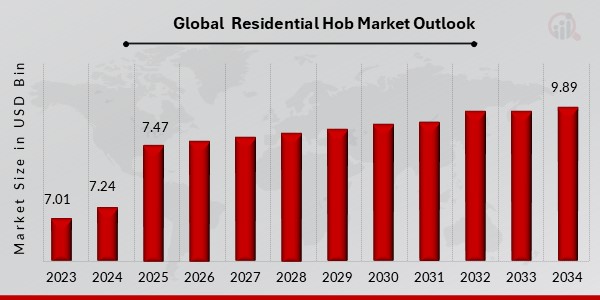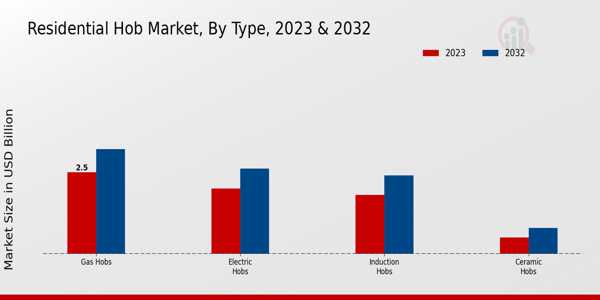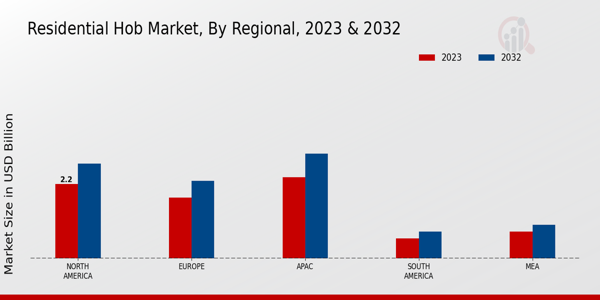Global Residential Hob Market Overview
The Residential Hob Market Size was estimated at 7.24 (USD Billion) in 2024. The Residential Hob Market Industry is expected to grow from 7.47 (USD Billion) in 2025 to 9.89 (USD Billion) by 2034. The Residential Hob Market CAGR (growth rate) is expected to be around 3.17% during the forecast period (2025 - 2034).

Source Primary Research, Secondary Research, MRFR Database and Analyst Review
Key Residential Hob Market Trends Highlighted
The Residential Hob Market is experiencing significant growth driven by the rising demand for energy-efficient appliances and the increasing focus on modern home cooking solutions. As consumers seek convenience and performance, manufacturers are innovating to create hobs that integrate advanced technologies such as induction cooking and smart controls. The shift toward sustainable living further propels this trend, as many homeowners prioritize appliances that minimize energy consumption while maximizing cooking efficiency. There are ample opportunities to be explored in this market, particularly in the realm of smart home integration.As smart homes become more prevalent, the ability to control hobs via mobile apps or voice commands presents an appealing feature for modern consumers. Additionally, the growing trend of cooking shows and culinary content on social media platforms is influencing consumer preferences, encouraging individuals to invest in high-quality, stylish cooking equipment that enhances their kitchen aesthetics. In recent times, there has been an observable trend toward versatile cooking appliances that cater to a range of cooking styles. Products that offer multifunctionality, such as combination hobs that can handle both gas and induction cooking, are gaining traction.The increasing popularity of home cooking, spurred by recent events, has intensified the focus on products that enhance culinary experiences. Another notable trend is the customization of products to fit various kitchen layouts and design preferences, allowing consumers to select hobs that seamlessly blend into their home interiors. As lifestyles evolve, the Residential Hob Market is poised for continuous development, driven by innovation and changing consumer demands.
Residential Hob Market Drivers
Increase in Urbanization and Housing Development
The Residential Hob Market Industry is experiencing robust growth due in part to the accelerating rate of urbanization worldwide. As more people move from rural areas to cities, the demand for residential properties has surged dramatically. This phenomenon is amplifying the need for modern housing solutions, with an increasing focus on advanced kitchen appliances, including residential hobs. Urban consumers tend to prioritize efficient, stylish, and functional kitchen equipment that enhances their cooking experience and fits seamlessly into contemporary kitchen designs.Additionally, new housing developments often feature modern amenities, and residential hobs are essential components of these new kitchen infrastructures. As urban populations continue to expand, the influx of residential constructions will drive significant demand for advanced hobs, thus catalyzing the overall market growth. This trend is also influenced by evolving consumer preferences toward eco-friendly and energy-efficient home appliances, which align with urban dwellers' lifestyles, further propelling the Residential Hob Market Industry into a promising growth trajectory.
Technological Advancements in Cooking Appliances
Technological innovation plays a crucial role in shaping the Residential Hob Market Industry, as manufacturers introduce advanced features and functionalities that enhance user convenience and cooking efficiency. The integration of smart technology, touch controls, and induction heating into residential hobs is particularly appealing to tech-savvy consumers looking for streamlined cooking experiences. Furthermore, advancements in energy efficiency not only cater to environmentally conscious buyers but also reduce utility costs, making modern hobs an attractive option for homeowners.As manufacturers continue to invest in research and development, the introduction of innovative products with enhanced capabilities is expected to stimulate market growth significantly.
Growing Influence of Culinary Shows and Food Culture
The growing popularity of culinary shows, social media cooking channels, and an increasing interest in gourmet cooking among consumers are driving demand within the Residential Hob Market Industry. As food culture gains prominence, more individuals are inspired to enhance their cooking skills, prompting them to invest in high-quality kitchen equipment, specifically hobs. This surge in interest is further supported by the rise of culinary enthusiasts, who share their cooking experiences online, highlighting the importance of advanced residential hobs in achieving professional-grade cooking results at home.As culinary skills become a focal point of home life, the demand for sophisticated hobs will likely continue to grow.
Residential Hob Market Segment Insights
Residential Hob Market Type Insights
The Residential Hob Market has showcased a varied landscape in terms of its Type segmentation, with prominent categories comprising Gas Hobs, Electric Hobs, Induction Hobs and Ceramic Hobs. As of 2023, Gas Hobs led this segment, holding a valuation of 2.5 billion USD, driven by a significant preference for traditional cooking methods among households that prioritize instant heat and precise control over flame intensity. This segment's importance is reflected in an expected rise to 3.2 billion USD by 2032, revealing a robust demand and a majority holding within the overall market. Electric Hobs, valued at 2.0 billion USD in 2023, caters to those seeking convenience and safety, indicating a steady growth trajectory as modern kitchens move towards easy-to-use appliances. By 2032, the Electric Hobs segment is projected to grow to 2.6 billion USD, marking its significant presence in the market and appealing to a growing urban population focused on efficiency.
Induction Hobs, valued at 1.8 billion USD in 2023 with projections to reach 2.4 billion USD by 2032, are becoming increasingly popular due to their energy efficiency and rapid cooking capabilities, as they utilize magnetic fields to heat cookware directly. This trend is seen as a response to rising energy concerns and preferences for smart appliances, showcasing increasing consumer awareness about environmental impact. Conversely, Ceramic Hobs, while representing the smallest market share at 0.5 billion USD in 2023, is expected to grow to 0.8 billion USD by 2032. Their segment might appear minor, but they play a role in providing aesthetic appeal and ease of cleaning, catering primarily to niche markets that value design in kitchen appliances.
The Residential Hob Market statistics reflect a dynamic evolution influenced by technological advancements, shifts in consumer preferences, and urbanization, marking essential opportunities and challenges that players must navigate to capitalize on emerging trends and changing demands.

Source Primary Research, Secondary Research, MRFR Database and Analyst Review
Residential Hob Market Material Insights
The material segment of this market includes Stainless Steel, Glass, Aluminium, and Ceramic, which together play a significant role in catering to consumer preferences. Stainless Steel is popular for its durability and ease of maintenance, while Glass offers aesthetic appeal and modern design, making it a favored choice among homeowners. Aluminum, being lightweight and conductive, also holds a substantial position, catering to the need for efficient cooking solutions.Ceramic is valued for its heat retention and scratch resistance, enhancing user experience. The Residential Hob Market segmentation reflects a diverse landscape that meets evolving consumer needs through varying materials. The market growth is driven by rising disposable incomes and advancements in kitchen technology, although challenges such as rising raw material costs may impact profitability. Overall, the Residential Hob Market data reveals valuable insights into material trends and consumer preferences for durability, design and functionality, contributing to the market's steady growth trajectory.
Residential Hob Market Number of Burners Insights
This aspect includes various configurations, such as Single Burner, Double Burner, Triple Burner, Four Burnerand Five Burner hobs. Among these, the Double Burner segment holds a significant place owing to its practicality for average household cooking, which often requires simultaneous dish preparation. Meanwhile, the Four Burner option dominates larger families and culinary enthusiasts, reflecting a trend towards versatile cooking solutions.The segment's growth is fueled by rising urbanization, an expanding middle class, and the increasing popularity of home-cooked meals. However, challenges such as competition from alternative cooking technologies may impact market growth. The Residential Hob Market statistics indicate a shift towards energy-efficient and compact designs, aligning with contemporary consumer expectations for sustainability. The market data also highlights that as kitchen designs evolve, consumers are considering aesthetics and functionality, enhancing the relevance of all burner configurations in the residential landscape.
Residential Hob Market Control Type Insights
The Control Type segment of the Residential Hob Market is crucial for enhancing user experience and convenience. This segment encompasses various types of controls, including Knobs, Touch Control and Slider Controls, each catering to distinct consumer preferences and technological advancements. Notably, Knobs have traditionally been a reliable choice due to their tactile feedback, while Touch Control is becoming increasingly popular among tech-savvy consumers for its sleek aesthetics and ease of cleaning.Slider Control offers a unique adjustable experience, allowing users to set precise temperatures, which enhances cooking efficiency. The diverse preferences in control types create opportunities for manufacturers to innovate, thus fueling the competitive landscape in the Residential Hob Market. As consumer demand continues to rise, understanding the Residential Hob Market segmentation will play a vital role in addressing market challenges and leveraging growth opportunities. Insights into the Residential Hob Market data reflect not only the trend toward modern and user-friendly interfaces but also the need for adaptability in a competitive industry landscape.
Residential Hob Market Regional Insights
North America leads the market with a valuation of 2.2 USD Billion in 2023, demonstrating a majority holding that highlights its strong consumer demand and innovative product offerings. Europe follows closely with a valuation of 1.8 USD Billion, driven by a trend towards energy-efficient cooking appliances that reflect sustainability efforts. The APAC region is also significant, valued at 2.4 USD Billion in 2023, benefiting from urbanization and rising disposable income, encouraging households to invest in modern cooking technologies.In contrast, South America, with a valuation of 0.6 USD Billion, and the MEA region at 0.8 USD Billion, are smaller markets but present important growth opportunities due to increasing home construction and modernization trends. These regional evaluations reflect dynamic market conditions shaped by consumer preferences, economic factors, and technology advancements, all influencing the Residential Hob Market revenue and overall market growth.

Source Primary Research, Secondary Research, MRFR Database and Analyst Review
Residential Hob Market Key Players and Competitive Insights
The Residential Hob Market is characterized by a dynamic landscape where various manufacturers compete for market share by offering innovative products that cater to the evolving preferences of consumers. This market has seen a notable acceleration in technological advancements, particularly as consumers increasingly demand energy-efficient and multifunctional cooking appliances. The competition is largely driven by factors such as product differentiation, pricing strategies, and brand loyalty, requiring companies to leverage unique selling propositions. In addition to traditional gas and electric models, there is a growing trend towards induction hobs and smart cooking solutions, which enhances competition among key players as they strive to meet consumer needs while adhering to strict regulatory standards regarding energy consumption and safety.Panasonic has established a significant presence in the Residential Hob Market, recognized for its commitment to innovation and technology. The company’s strengths lie in its ability to integrate smart technology features into its hob designs, which enhances user convenience and cooking efficiency. Panasonic emphasizes energy efficiency, a crucial factor for today’s environmentally conscious consumers. Their products have a reputation for reliability and high performance, which strengthens brand loyalty among existing customers. Furthermore, the company's innovative approach, characterized by sleek designs and usability, positions Panasonic favorably against its competitors, appealing to consumers who prioritize modern aesthetics along with functionality in their kitchen appliances. This strategic focus on technology and design enhances Panasonic's competitiveness within the residential hob market.Indesit is another notable player in the Residential Hob Market, characterized by a strong emphasis on practicality and affordability. The company has cultivated a solid reputation for providing reliable cooking solutions that meet the fundamental needs of homeowners. Indesit's offerings are often praised for their straightforward functionality and user-friendly features, making them accessible to a broad range of consumers, including those looking for cost-effective options. The brand’s commitment to quality while maintaining competitive pricing allows Indesit to attract budget-conscious households without compromising on performance. This strategic approach solidifies Indesit’s market position, particularly in regions where affordability is a significant consideration in purchasing decisions. Indesit balances innovation with practicality, enabling it to cater to diverse customer preferences in a progressively competitive market.
Key Companies in the Residential Hob Market Include
- Panasonic
- Indesit
- Whirlpool
- Electrolux
- LG Electronics
- Samsung
- Miele
- GE Appliances
- Beko
- Zanussi
- Bosch
- Blomberg
- Smeg
- Siemens
- Fisher and Paykel
Residential Hob Market Industry Developments
Recent developments in the Residential Hob Market exhibit a dynamic landscape, particularly with major brands such as Panasonic, Whirlpool and LG Electronics increasingly focusing on smart technology integration and energy efficiency. Companies like Electrolux and Bosch are also enhancing their offerings to meet consumer demand for innovative cooking solutions. The market has witnessed significant growth in the valuation of these companies, influenced by rising consumer preferences for sustainable and high-performance appliances.In terms of mergers and acquisitions, there have been notable movements, particularly in partnerships aimed at expanding product portfolios and geographic reach. For instance, Indesit and GE Appliances have made headlines for their strategic collaborations to leverage each other’s technologies and market strengths. Meanwhile, Samsung's focus on smart home integration has prompted it to explore alliances with tech firms to enhance the functionality of its hobs. As established brands like Siemens and Miele continue to invest in research and development, their efforts to deliver advanced products are shaping the competitive landscape, underlining the industry's commitment to innovation amidst evolving consumer expectations.
Residential Hob Market Segmentation Insights
Residential Hob Market Type Outlook
- Gas Hobs
- Electric Hobs
- Induction Hobs
- Ceramic Hobs
Residential Hob Market Material Outlook
- Stainless Steel
- Glass
- Aluminium
- Ceramic
Residential Hob Market Number of Burners Outlook
- Single Burner
- Double Burner
- Triple Burner
- Four Burner
- Five Burner
Residential Hob Market Control Type Outlook
- Knobs
- Touch Control
- Slider Control
Residential Hob Market Regional Outlook
- North America
- Europe
- South America
- Asia Pacific
- Middle East and Africa
| Report Attribute/Metric |
Details |
| Market Size 2024 |
7.24(USD Billion) |
| Market Size 2025 |
7.47 (USD Billion) |
| Market Size 2034 |
9.89 (USD Billion) |
| Compound Annual Growth Rate (CAGR) |
3.17% (2025 - 2034) |
| Report Coverage |
Revenue Forecast, Competitive Landscape, Growth Factors, and Trends |
| Base Year |
2023 |
| Market Forecast Period |
2025 - 2034 |
| Historical Data |
2019 - 2023 |
| Market Forecast Units |
USD Billion |
| Key Companies Profiled |
Panasonic, Indesit, Whirlpool, Electrolux, LG Electronics, Samsung, Miele, GE Appliances, Beko, Zanussi, Bosch, Blomberg, Smeg, Siemens, Fisher and Paykel |
| Segments Covered |
Type, Material, Number of Burners, Control Type, Regional |
| Key Market Opportunities |
1. Smart technology integration, 2. Energy-efficient designs, 3. Customizable aesthetic options, 4. Rising demand in urban areas, 5. Sustainable cooking solutions |
| Key Market Dynamics |
1. Rising urbanization and housing demand, 2. Increasing focus on energy efficiency, 3. Growth of smart home technology, 4. Shift towards induction hobs, 5. Consumer preference for premium features |
| Countries Covered |
North America, Europe, APAC, South America, MEA |
Frequently Asked Questions (FAQ) :
The Residential Hob Market is expected to be valued at 9.89 billion USD in 2034.
The market is projected to grow at a CAGR of 3.17% from 2025 to 2034.
Gas Hobs are expected to have a significant market share, valued at 3.2 billion USD in 2032.
Electric Hobs are projected to reach a market value of 2.6 billion USD by 2032.
The market value for Induction Hobs is expected to be 2.4 billion USD in 2032.
North America is expected to dominate, with a market value of 2.8 billion USD in 2032.
The APAC region is anticipated to reach a market size of 3.1 billion USD in 2032.
Key players include Panasonic, Whirlpool, Electrolux, and Samsung, among others.
Ceramic Hobs are projected to achieve a market size of 0.8 billion USD in 2032.
Regional demand influences the market significantly, particularly in North America and APAC, prompting variations in market values.


















